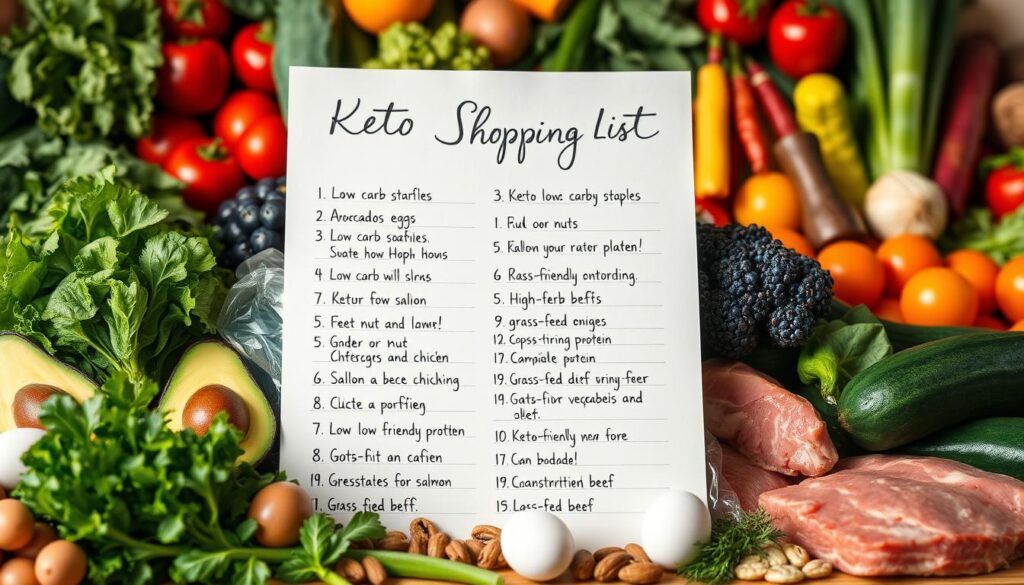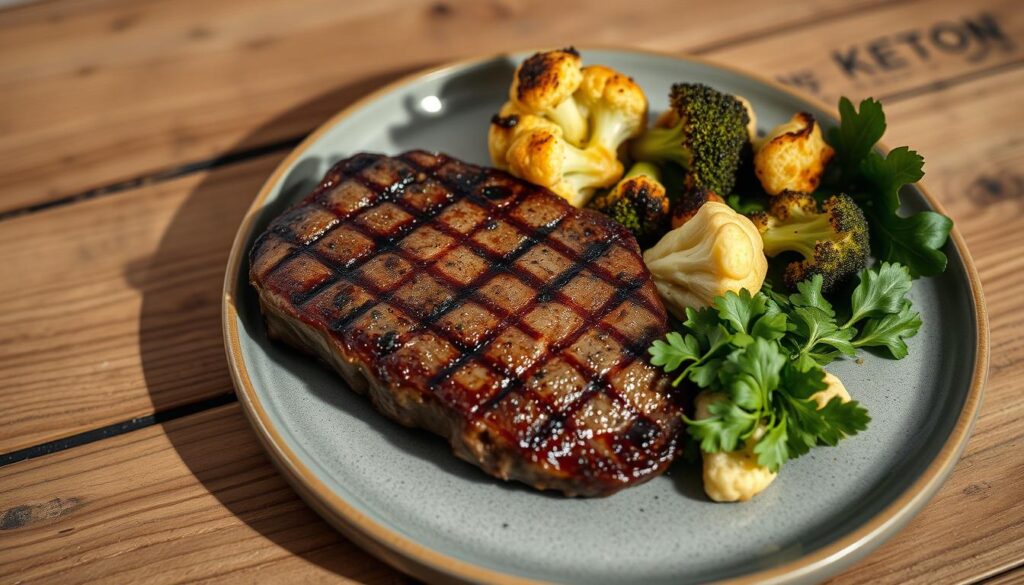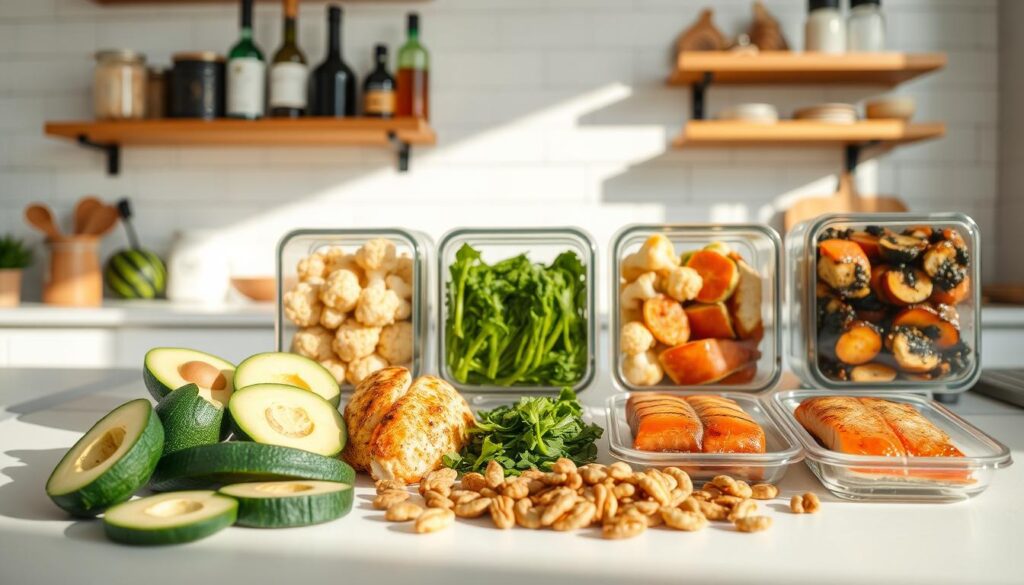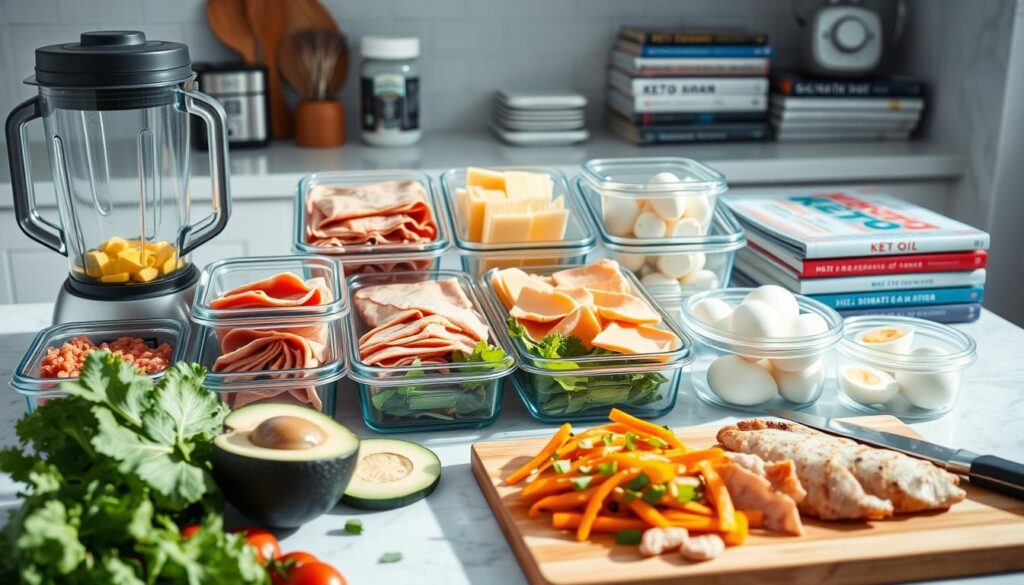The ketogenic diet, a metabolic state where the body burns fat for energy instead of carbs, has gained popularity due to its numerous health benefits, including weight loss and improved blood sugar control.
By drastically reducing carbohydrate intake and replacing it with fat, the body enters a state of ketosis. This significant shift in metabolism can lead to various health benefits.
For those new to the keto lifestyle, understanding its basics is crucial. The diet involves consuming a very low amount of carbohydrates and replacing them with fat to help your body burn fat for energy.
Key Takeaways
- The ketogenic diet involves a drastic reduction in carbohydrate intake.
- Replacing carbs with fat leads to a metabolic state called ketosis.
- Ketosis enables the body to burn fat for energy.
- The keto diet is associated with weight loss and improved blood sugar control.
- Understanding the basics is crucial for beginners.
Understanding the Ketogenic Diet Fundamentals
The ketogenic diet is a metabolic approach that has gained popularity for its potential to induce weight loss and improve overall health. Ketosis, a metabolic state where the body burns fat for fuel, is the core of the ketogenic diet. To achieve this state, the body must switch from relying on glucose to relying on ketones, which are produced by the liver from fat breakdown.
What Is Ketosis and Why It Works
Ketosis occurs when the body’s carbohydrate stores are depleted, and it begins to break down fat for energy, producing ketones in the process. This metabolic switch is crucial for entering ketosis. Modifying your diet to be high in fat, moderate in protein, and low in carbohydrates is key to achieving this metabolic state.
The Metabolic Switch Explained
The metabolic switch refers to the body’s transition from relying on glucose (sugar) for energy to relying on ketones (fat). This switch is facilitated by significantly reducing carbohydrate intake, thereby depleting glucose stores, and increasing fat consumption.
For those new to the ketogenic diet, understanding optimal ketone levels is crucial. Generally, a ketone level between 0.5 and 3 mmol/L is considered within the therapeutic range for most individuals on a ketogenic diet.
The Science Behind Fat Adaptation
Fat adaptation refers to the body’s ability to efficiently burn fat for fuel, a process that occurs after the initial adaptation to the ketogenic diet. As the body adapts, it becomes more efficient at burning fat, leading to increased energy levels and potentially improved mental clarity.
Common Misconceptions About Keto
Despite its growing popularity, the ketogenic diet is often misunderstood. One common misconception is that it’s a high-protein diet; however, the keto diet is actually characterized by being high in fat. Another misconception is that it’s unhealthy due to the high fat intake, but research has shown that the type of fat consumed is more important than the quantity.
Benefits Beyond Weight Loss: Why Go Keto
The ketogenic diet is not just about losing weight; it’s about achieving overall wellness. By adopting a keto lifestyle, individuals can experience a range of benefits that improve their overall health and quality of life.
Mental Clarity and Cognitive Benefits
Many individuals on the keto diet report improved mental clarity and focus. The diet’s impact on cognitive function is significant, with some studies suggesting that the keto diet may have neuroprotective effects. This could be due to the increased production of brain-derived neurotrophic factor (BDNF), a protein that plays a crucial role in brain health.
Energy Level Improvements
The keto diet is known for its ability to boost energy levels. By switching the body’s primary fuel source from glucose to ketones, individuals often experience a more stable and sustained energy supply. This is particularly beneficial for those who lead active lifestyles or have demanding physical routines.
Potential Health Markers That Improve
The keto diet has been shown to positively impact various health markers. Two significant areas of improvement are:
- Blood Sugar Regulation: The diet can help improve insulin sensitivity and glucose metabolism, making it beneficial for individuals with type 2 diabetes or prediabetes.
- Inflammation Reduction: By reducing carbohydrate intake, especially from high-glycemic sources, the keto diet can help lower systemic inflammation, which is associated with various chronic diseases.
| Health Marker | Potential Improvement |
|---|---|
| Blood Sugar Regulation | Improved insulin sensitivity |
| Inflammation Reduction | Lower systemic inflammation |

By understanding these benefits, individuals can make an informed decision about adopting a keto lifestyle. The diet offers a holistic approach to health, focusing not just on weight loss, but on overall well-being and disease prevention.
Keto Made Easy: A Beginner’s Roadmap
Embarking on a ketogenic lifestyle is easier than you think with a simple, step-by-step approach. To make keto dieting straightforward, it’s essential to be equipped with the right tools and knowledge.
Essential Kitchen Tools and Pantry Staples
To start your keto journey, you’ll need some basic kitchen tools. These include a digital kitchen scale for measuring ingredients accurately, a large skillet or wok for cooking, and a refrigerator with separate compartments for storing keto-friendly foods.
Must-Have Ingredients List
Stock your pantry with staples like healthy oils (olive, coconut, and avocado oil), low-carb vegetables (spinach, broccoli, cauliflower), quality protein sources (eggs, fish, poultry), and full-fat dairy or dairy alternatives (cheese, full-fat yogurt, almond milk). Having these essentials on hand makes meal planning effortless.

Simple Macro Calculations Without the Math Headache
Calculating macros can be simple. A standard keto diet typically consists of 70-80% fat, 15-20% protein, and 5-10% carbohydrates. To simplify, you can use a macro calculator or a keto diet app that does the math for you, ensuring you stay within your daily carb limit.
| Macro | Percentage | Example (2000 calories) |
|---|---|---|
| Fat | 70-80% | 156g |
| Protein | 15-20% | 75g |
| Carbohydrates | 5-10% | 25g |
First Week Survival Guide
The first week on keto can be challenging, but being prepared helps. Expect potential keto flu symptoms like fatigue and headaches. Stay hydrated, and consider electrolyte supplements to mitigate these effects.
Day-by-Day Expectations
- Day 1-2: High anticipation, potential withdrawal symptoms.
- Day 3-4: Symptoms peak, start noticing decreased cravings.
- Day 5-7: Energy levels stabilize, mental clarity improves.
By following this roadmap, beginners can navigate the keto diet with confidence, making the transition smoother and more manageable.
Navigating the Grocery Store: Keto Shopping List
To successfully follow a keto diet, it’s crucial to know what to look for when navigating the grocery store aisles. A well-structured keto shopping list is your roadmap to making the most out of your diet.
Protein Sources to Prioritize
When it comes to protein, variety is key. Prioritize meat, fish, and eggs as they are staples of a keto diet. Opt for grass-fed beef, wild-caught fish, and pasture-raised eggs for the highest nutrient intake.
- Beef: Ribeye, sirloin, and ground beef
- Fish: Salmon, mackerel, and sardines
- Eggs: Pasture-raised eggs for the best fatty acid profile
Healthy Fats to Embrace
Healthy fats are a crucial component of a keto diet, providing the necessary calories and supporting overall health. Focus on:
- Avocados
- Nuts and seeds (almonds, walnuts, chia seeds)
- Olive oil and avocado oil
- Fatty cuts of meat and fish

Low-Carb Vegetables and Fruits
Vegetables and some fruits are essential for fiber, vitamins, and minerals. Choose low-carb options like:
- Leafy greens (spinach, kale)
- Broccoli, cauliflower, and asparagus
- Tomatoes and avocados (yes, they’re a fruit!)
- Berries in moderation (strawberries, blueberries)
Hidden Carbs to Avoid
Be mindful of hidden carbs in processed foods, sauces, and dressings. Always read labels carefully.
Label Reading 101
To avoid hidden carbs, it’s essential to read labels effectively. Check the total carbohydrate count, and be wary of:
| Label Section | What to Look For |
|---|---|
| Total Carbohydrates | Less than 5g per serving |
| Ingredients | Avoid added sugars, high-carb ingredients |
| Nutritional Claims | “Low-carb,” “Sugar-free,” or “Keto-friendly” |
By being aware of these factors, you can make informed choices that keep you on track with your keto diet.
Quick and Simple Keto Meal Planning
One of the keys to keto success lies in easy and efficient meal planning. By having a clear plan, you can avoid last-minute, high-carb decisions that derail your diet.
Breakfast Ideas That Take Minutes
Starting your day with a keto-friendly breakfast is easier than you think. Consider scrambled eggs with spinach or a keto smoothie made with avocado, coconut milk, and protein powder.
No-Cook Morning Options
For busy mornings, no-cook options are a lifesaver. Try a keto yogurt parfait with Greek yogurt, berries, and chopped nuts, or a keto coffee with coconut oil and heavy cream.
Lunch Options for Work and Home
Lunch can be as simple as a salad with grilled chicken or salmon, topped with olive oil and vinegar. For a more filling option, consider a keto wrap made with a low-carb tortilla, filled with turkey, avocado, and bacon.
Dinner Recipes the Whole Family Will Enjoy
Dinner doesn’t have to be complicated. Baked salmon with roasted vegetables is a quick and delicious option. Alternatively, try a keto beef stir-fry with broccoli, bell peppers, and your favorite seasonings.
Smart Snacking Strategies
Snacking is an essential part of staying keto. Keep healthy options like cheese sticks, hard-boiled eggs, and keto trail mix on hand.
Emergency Keto Snack Kit
Prepare an emergency snack kit with items like macadamia nuts, dark chocolate (at least 85% cocoa), and jerky. This kit will help you avoid reaching for high-carb snacks when you’re in a pinch.
Batch cooking delicious keto meals will help you stay on track with your keto macros throughout the week. Consider dedicating a few hours on the weekend to meal prep.
| Meal | Keto-Friendly Option | Macro Breakdown |
|---|---|---|
| Breakfast | Scrambled Eggs with Spinach | 320 Calories, 26g Fat, 5g Protein, 2g Carbs |
| Lunch | Grilled Chicken Salad | 400 Calories, 32g Fat, 25g Protein, 5g Carbs |
| Dinner | Baked Salmon with Broccoli | 350 Calories, 24g Fat, 30g Protein, 5g Carbs |

Overcoming Common Keto Challenges
While the keto diet offers numerous benefits, it’s not without its challenges; knowing how to overcome these is crucial. As you transition into a ketogenic lifestyle, understanding how to navigate initial hurdles can make a significant difference in your success.
Conquering the Keto Flu
The keto flu is a common phenomenon experienced by many when starting the diet. It can be mitigated by easing into the diet and taking mineral supplements. Electrolyte balancing is key.
Electrolyte Balancing Made Simple
Ensuring adequate intake of sodium, potassium, and magnesium can help alleviate keto flu symptoms. Incorporating foods rich in these minerals or supplementing can make the transition smoother.
Dealing with Cravings and Social Pressure
Cravings and social pressure are significant challenges many face on the keto diet. Planning ahead and having keto-friendly options available can help. “The key to success is not avoiding challenges, but learning how to navigate them effectively.”

Plateau Solutions That Actually Work
Hitting a plateau can be discouraging, but there are strategies to overcome it. Adjusting your macro ratios or incorporating intermittent fasting can help.
When to Implement Intermittent Fasting
Intermittent fasting can be an effective tool for breaking through a plateau. It’s essential to listen to your body and adjust your fasting schedule accordingly.
By understanding and addressing these common keto challenges, you can navigate your ketogenic journey more effectively, achieving your health and weight loss goals.
Keto on a Budget: Affordable Approaches
Adopting a keto diet can be affordable when you know the right shopping and cooking strategies. With a little planning, you can enjoy the benefits of a ketogenic lifestyle without breaking the bank.
Cost-Effective Protein Options
Protein is a crucial component of a keto diet, but it doesn’t have to be expensive. Consider the following cost-effective protein sources:
- Eggs: A versatile and affordable option, eggs are rich in protein and healthy fats.
- Canned Fish: Canned tuna, salmon, and sardines are not only budget-friendly but also packed with omega-3 fatty acids.
- Organ Meats: Organ meats like liver and kidney are nutrient-dense and often cheaper than traditional cuts of meat.
Seasonal Shopping Strategies
Buying produce in season can significantly reduce your grocery bills. Here’s how to make the most of seasonal shopping:
- Plan your meals around what’s in season.
- Shop at local farmers’ markets or join a community-supported agriculture (CSA) program.
As Dr. Eric Berg once said, “Eating seasonally is not just about saving money; it’s about eating foods at their nutritional peak.” This approach can help you maintain a balanced keto diet while keeping costs down.
Batch Cooking to Save Time and Money
Batch cooking is a powerful strategy for saving both time and money. By preparing meals in advance, you can avoid last-minute takeouts and reduce food waste.
Sunday Prep Plan for Weekly Success
Dedicate a few hours on Sunday to meal prep for the week. Here’s a simple plan:
| Meal | Protein Source | Vegetables |
|---|---|---|
| Breakfast | Scrambled Eggs | Spinach, Mushrooms |
| Lunch | Grilled Chicken | Broccoli, Cauliflower |
| Dinner | Baked Salmon | Green Beans, Zucchini |
By following this plan, you can enjoy a variety of keto meals throughout the week without the daily hassle of cooking.

Keto for Busy Lifestyles: Time-Saving Hacks
Being keto on the go is not only possible but also practical with a few simple hacks. For individuals with busy lifestyles, incorporating a ketogenic diet can seem daunting, but with the right strategies, it can be a breeze. The key is to have convenient, keto-friendly options readily available to avoid being caught off guard.
5-Minute Meal Ideas
For those in a hurry, having quick keto meal ideas is a lifesaver. Some examples include:
- Avocado and Bacon Roll-Ups: A simple, satisfying snack that requires minimal preparation.
- Keto Coffee with MCT oil or butter: An energizing beverage that combines fat and flavor.
- Hard-Boiled Eggs: A protein-packed snack that’s easy to prepare in advance.
Make-Ahead Meals That Freeze Well
Preparing meals in advance is a great way to save time. Some keto-friendly options that freeze well include:
| Meal | Preparation Time | Freezer Life |
|---|---|---|
| Keto Lasagna | 30 minutes | 3 months |
| Casseroles | 20-40 minutes | 2-3 months |
| Meatballs | 15 minutes | 2 months |
Restaurant Ordering Guide
Eating out on keto can be straightforward with a little know-how. Here are some tips:
- Opt for Protein-Rich Dishes: Focus on dishes with a good protein source like steak or chicken.
- Customize Your Order: Don’t hesitate to ask for modifications, like holding the bun or substituting veggies for fries.
Fast Food Keto Options
Even fast food can be keto-friendly with the right choices. Some keto options include:
- Bun-less Burgers: Many fast-food chains offer this as an option.
- Salads with Protein: Just be mindful of the dressing.
Travel Tips for Staying Keto
Traveling keto doesn’t have to be complicated. Here are some travel tips:
- Pack Snacks: Bringing keto-friendly snacks can be a lifesaver during long trips.
- Research Restaurants: Before traveling, look up keto-friendly restaurants at your destination.

Tracking Progress Beyond the Scale
Tracking progress on a keto diet involves more than just monitoring weight loss; it encompasses a range of physical, mental, and emotional improvements. As you journey through the ketogenic lifestyle, it’s crucial to celebrate the victories that aren’t reflected on the scale.
Non-Scale Victories to Celebrate
Non-scale victories are the achievements that make your keto journey worthwhile. These victories can include:
- Increased energy levels
- Improved mental clarity
- Better sleep quality
- Enhanced physical performance
- Reduced inflammation
These benefits are often more significant indicators of your progress than the number on the scale. By focusing on these non-scale victories, you can stay motivated and encouraged throughout your keto journey.
Physical and Mental Improvements to Watch For
As you progress on your keto diet, pay attention to the physical and mental improvements that you’re experiencing. You may notice:
- Improved body composition, with increased muscle tone and decreased body fat percentage
- Better mental clarity and focus, allowing you to tackle daily tasks with ease
- Enhanced physical performance, whether you’re engaging in regular exercise or simply performing daily activities
These improvements can be tracked through various methods, including regular body measurements, progress photos, and how you feel throughout the day.
Simple Tracking Methods That Don’t Consume Your Life
To effectively track your keto progress without getting overwhelmed, you can use simple and practical methods. Some of these methods include:
- Regularly tracking your ketone levels using urine strips, blood meters, or breath analyzers
- Monitoring your food intake and macros using a food diary or mobile app
- Taking progress photos to visualize changes in your body composition
These tracking methods provide valuable insights into your progress without consuming too much of your time.
![]()
When and How to Adjust Your Approach
As you track your keto progress, it’s essential to know when and how to adjust your approach. If you’re not seeing the desired results, it may be necessary to:
- Reassess your macro intake to ensure you’re meeting your dietary needs
- Adjust your food choices to optimize your nutrient intake
- Increase your physical activity to boost your metabolism and overall health
Troubleshooting Common Issues
When troubleshooting common issues on a keto diet, consider the following:
- Inconsistent ketone levels? Check your diet for hidden carbs and adjust your macro intake accordingly.
- Plateaus? Reassess your overall lifestyle, including your diet, exercise, and stress levels, to identify areas for improvement.
By being proactive and adjusting your approach as needed, you can overcome common challenges and stay on track with your keto journey.
Conclusion: Your Sustainable Keto Journey
Embracing a ketogenic lifestyle can be a transformative experience, leading to improved overall health and well-being. As you’ve learned, maintaining keto long-term requires a deep understanding of the diet’s fundamentals and a commitment to making sustainable lifestyle changes.
By steering clear of carbohydrates and incorporating the keto tips outlined in this article, you’ll be well on your way to achieving a sustainable keto journey. This journey is not just about reaching a specific goal, but about adopting a healthier, more balanced lifestyle that you can maintain for years to come.
As you continue on your keto path, remember that consistency and patience are key. Stay focused, and you’ll be rewarded with the many benefits that a well-implemented ketogenic diet has to offer, from improved mental clarity to enhanced overall health.



